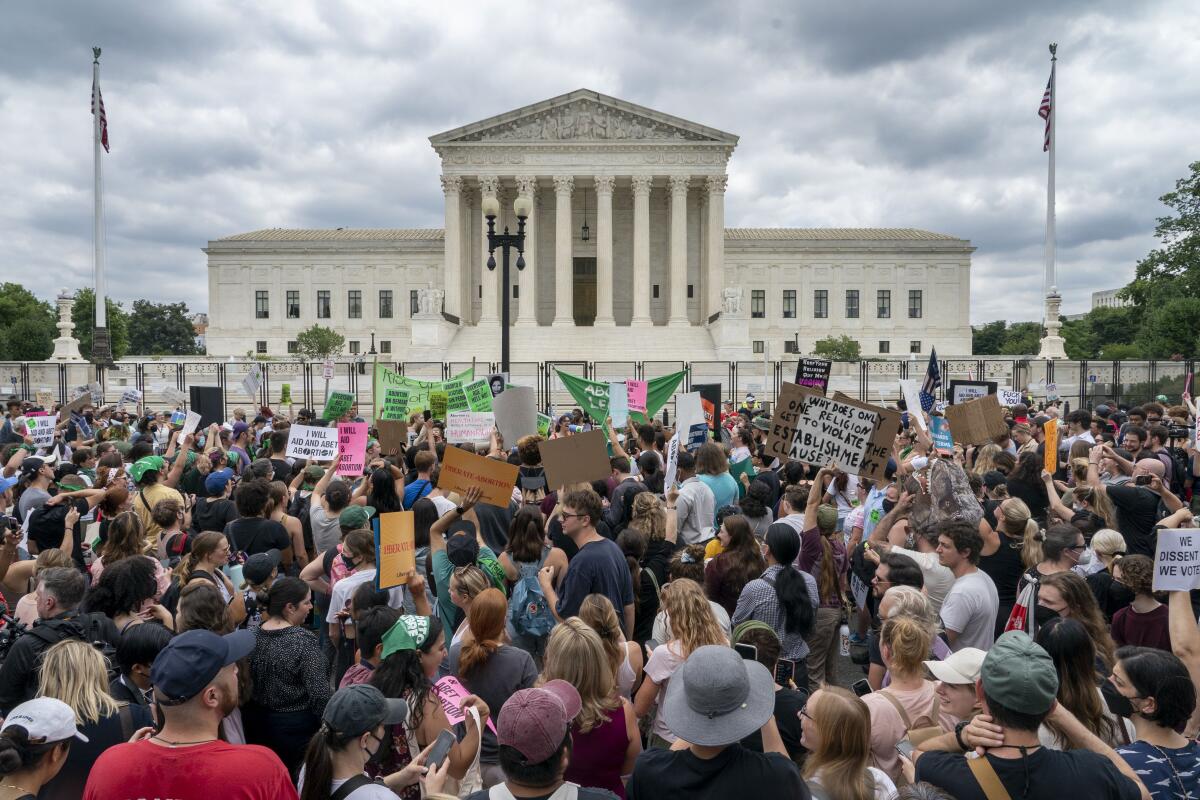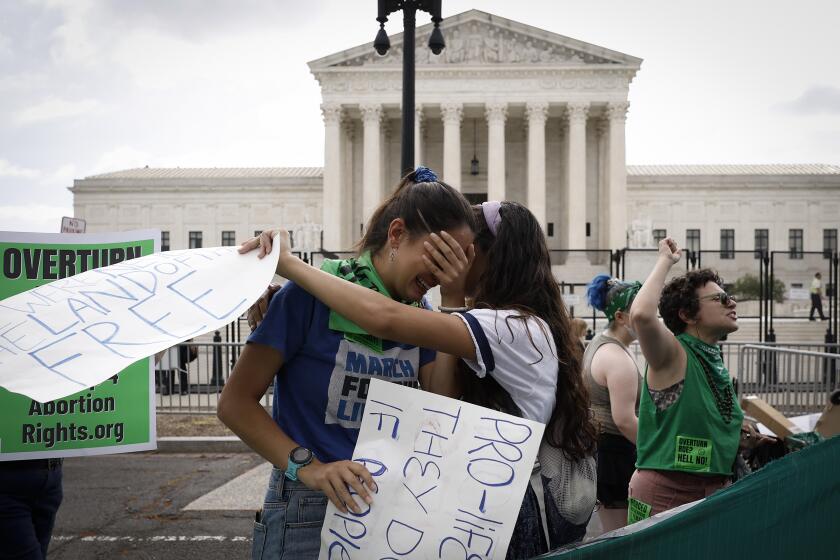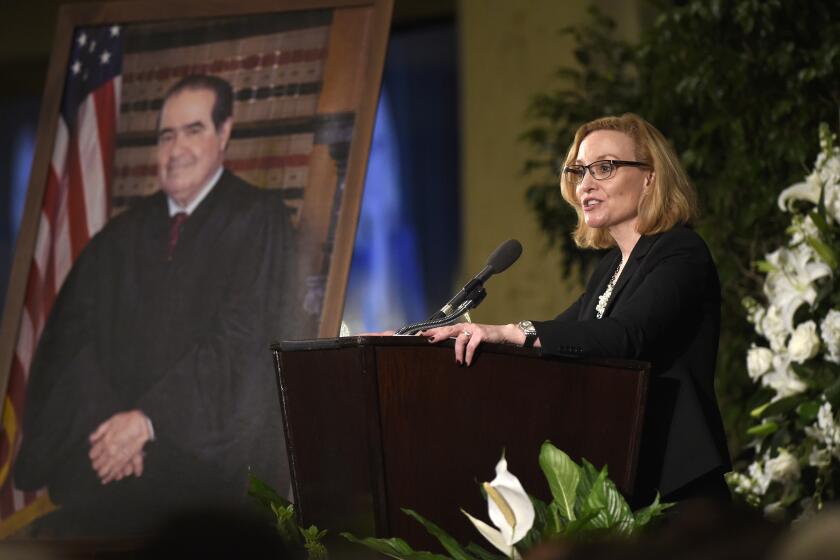News Analysis: Supreme Court is emboldened, conservative and ready to push further right

- Share via
WASHINGTON — This is not the Supreme Court most Americans have known.
Since Chief Justice Earl Warren retired in 1969, ending an era of liberal activism, the high court has been dominated by moderates.
They included Lewis Powell, a soft-spoken Southern lawyer appointed by President Nixon, and Sandra Day O’Connor and Anthony M. Kennedy, both appointed by President Reagan.
They were not scholars and did not espouse an ideology or a methodology for deciding cases. But they brought wisdom and practical experience to deciding the hardest issues, and in O’Connor’s case, political know-how as well. She had been the Republican leader of the Arizona Senate before becoming a judge, and she knew how to forge a compromise.
Year after year, they kept the court on a middle course. Most terms ended with a mix of rulings, some that pleased conservatives and others that heartened liberals.
That has all changed. There is no longer a moderate in the middle, as proved by three big conservative wins this week. The justices on Friday struck down Roe vs. Wade, the 1973 landmark opinion establishing a woman’s right to abortion. That came a day after they jettisoned a century-old New York law that restricted the carrying of concealed handguns on the streets. On Tuesday, they threw out a Maine law that prohibited allowing parents to use state aid to pay tuition at religious schools.
With the exception of Chief Justice John G. Roberts Jr., the most conservative Supreme Court justices are not interested in seeking middle ground or in standing by the decisions of decades past. They believe the right answer can be found in the “original” history of the Constitution as written in the 18th or 19th century, an era when women and African Americans had no voice and no vote.
In a historic reversal, the Supreme Court strikes down a half-century of nationwide abortion rights in the U.S.
The rulings on abortion, guns and religion reflect how far the court has moved.
In the fall of 1971, Powell had just been confirmed when the justices were weighing the abortion issue. Years before, he had counseled a distraught young man in his law firm who confided that his girlfriend had died of a botched abortion. Men and women of his time knew of such stories of tragic deaths.
To the surprise of his new colleagues, Powell said the abortion laws needed to change, and he would support a new right to abortion. The Constitution protects the right to liberty, he said in a 1979 interview, and that includes “the liberty to make certain highly personal decisions that are terribly important to people. It’s difficult to think of a decision that’s more personal or important to a pregnant woman than whether or not she will bear a child.”
Once Powell had spoken, it was clear there was a majority within the court to rule that women had a right to choose abortion. And that’s what happened when the court ruled 7-2 in Roe vs. Wade in 1973.
Law can be like physics. Each action has an equal and opposite reaction. In this case, not long after the high court issued its decision, a powerful “right to life” movement sprang into existence and found a home in the Republican Party.
Two decades later, the court had been transformed by the justices appointed by Presidents Reagan and George H.W. Bush. And it seemed poised to overturn the right to abortion.
But in a surprise, O’Connor and Kennedy joined an opinion to uphold the right. Kennedy had agonized over the abortion issue. He was a Catholic who believed abortion was immoral, but he also believed the Constitution protected the liberty of individuals against the dictates of the government.
That decision, in Planned Parenthood vs. Casey, came as a shock to the conservative legal movement. The lesson they took from it was that future Republican appointees must be reliably conservative on abortion. Influential conservative legal groups, such as the Federalist Society, began scrubbing backgrounds of potential Supreme Court justices to ensure they would not waver from overturning Roe.
Among those who passed that test was Samuel A. Alito Jr., a federal appeals judge who as a young Reagan administration lawyer had said he looked forward to arguing for Roe vs. Wade to be overturned. He was appointed to the court in 2006 by President George W. Bush.
Alito spoke for a 5-4 majority in Friday’s ruling in Dobbs vs. Jackson Women’s Health Organization. The Roe decision was “egregiously wrong” from the start, he said, because the 14th Amendment’s protection for liberty and equality in 1868 cannot be understood to have created a right to abortion.
Near the close of his 79-page opinion, Alito said state legislatures have almost unlimited authority to forbid or criminalize abortions. The state’s “legitimate interests include respect for and preservation of prenatal life at all stages of development,” he said. There was no mention of possible exceptions in cases of rape, incest or a severe fetal deformity. The court’s other most conservative justices — Clarence Thomas, Neil M. Gorsuch, Brett M. Kavanaugh and Amy Coney Barrett — joined Alito.
Roberts, perhaps channeling O’Connor and Kennedy, tried to propose a middle ground. “I would take a more measured course,” he said, by upholding Mississippi’s 15-week limit on abortions, but not jettisoning Roe. He said the court’s precedents make clear women have a “right to choose” abortion, and that means they should have a “reasonable opportunity to choose.” By 15 weeks, women have known they are pregnant, he said, so the right “need not extend any further.”
His proposal could have led to a moderate-conservative ruling that is in line with public opinion. Most Americans support the right to abortion early in a pregnancy, but most say they are opposed to later abortions. A switch by one justice could have changed the outcome, but none of his fellow conservatives were willing to join the chief justice.
Roe vs. Wade went from ‘settled’ law to overruled in a few years, thanks to four unexpected developments.
While giving states broad power to restrict abortion, the court in its guns decision cast doubt on all manner of state and local laws that restrict firearms.
There too the court moved away from a moderate-conservative position that Kennedy had staked out.
For most of its history, the court held that the 2nd Amendment was meant to ensure armed citizens could respond to a crisis as part of a “well-regulated Militia” and allowed states wide latitude in regulating ownership and possession of firearms. In more recent decades, gun rights advocates pushed a different interpretation that focused on the amendment’s closing words that “the right of the people to keep and bear arms shall not be infringed.”
In 2008, the court in a 5-4 decision adopted that reasoning and ruled the 2nd Amendment protects an individual’s right to be armed for self-defense. Its decision struck down an unusually strict ordinance in Washington, D.C., that prohibited all private possession of handguns; two years later, the court voided a similar ordinance in Chicago.
The impact of those rulings were minimal, however. Kennedy believed both that people had a right to have a gun at home and that firearms were subject to reasonable regulations by cities and states. For a decade, the court turned away gun rights challenges to laws and ordinances, including several from California.
After Kennedy retired in 2018 and Kavanaugh and Barrett joined the court, the conservative bloc was ready to begin expanding the scope of the 2nd Amendment.
“The constitutional right to bear arms in public for self defense is not a second-class right,” Thomas wrote in New York State Rifle & Pistol Assn. vs. Bruen. The decision struck down laws in New York, California and four other states that make it hard for gun owners to obtain permits to carry a concealed weapon.
The ramifications of this ruling will not be known for years, however, and it raises plenty of questions. Does it mean there is a constitutional right to carry a loaded gun when walking on 5th Avenue in New York? Or on the subway or in restaurants and bars? Does it also mean an 18-year-old has a right to buy and carry a rapid-fire rifle? The court’s opinion does not try to answer those questions, but it notes that guns are prohibited in courthouses.
The new court is also prepared to knock down another 1970s-era compromise on the role affirmative action plays in admissions to colleges and universities.
In 1978, the court was split on whether to reject a University of California policy that set aside several slots for minority students at the UC Davis Medical School. Four justices thought this was an illegal quota, and four others thought it was reasonable affirmative action.
Powell was in the middle. He thought the set-asides were illegal, but he wrote approvingly of an admissions policy that used a student’s race as one “plus” factor to bring about diversity on campus.
In Regents of the University of California vs. Bakke, Powell set the standard for admissions policies, and it was upheld later by O’Connor and Kennedy.
This fall, the justices will take up anti-discrimination challenges to the admissions policies at Harvard and the University of North Carolina. They are almost certain to rule that any use of race in admissions is illegal and unconstitutional.
The court’s three Trump appointees — Gorsuch, Kavanaugh and Barrett — are still new, but they have already had a powerful impact. They show all signs of being ready to press ahead with a conservative agenda, while the middle-of-the-road philosophy of O’Connor and Kennedy slips further into the court’s rearview mirror.
More to Read
Get the L.A. Times Politics newsletter
Deeply reported insights into legislation, politics and policy from Sacramento, Washington and beyond. In your inbox three times per week.
You may occasionally receive promotional content from the Los Angeles Times.













